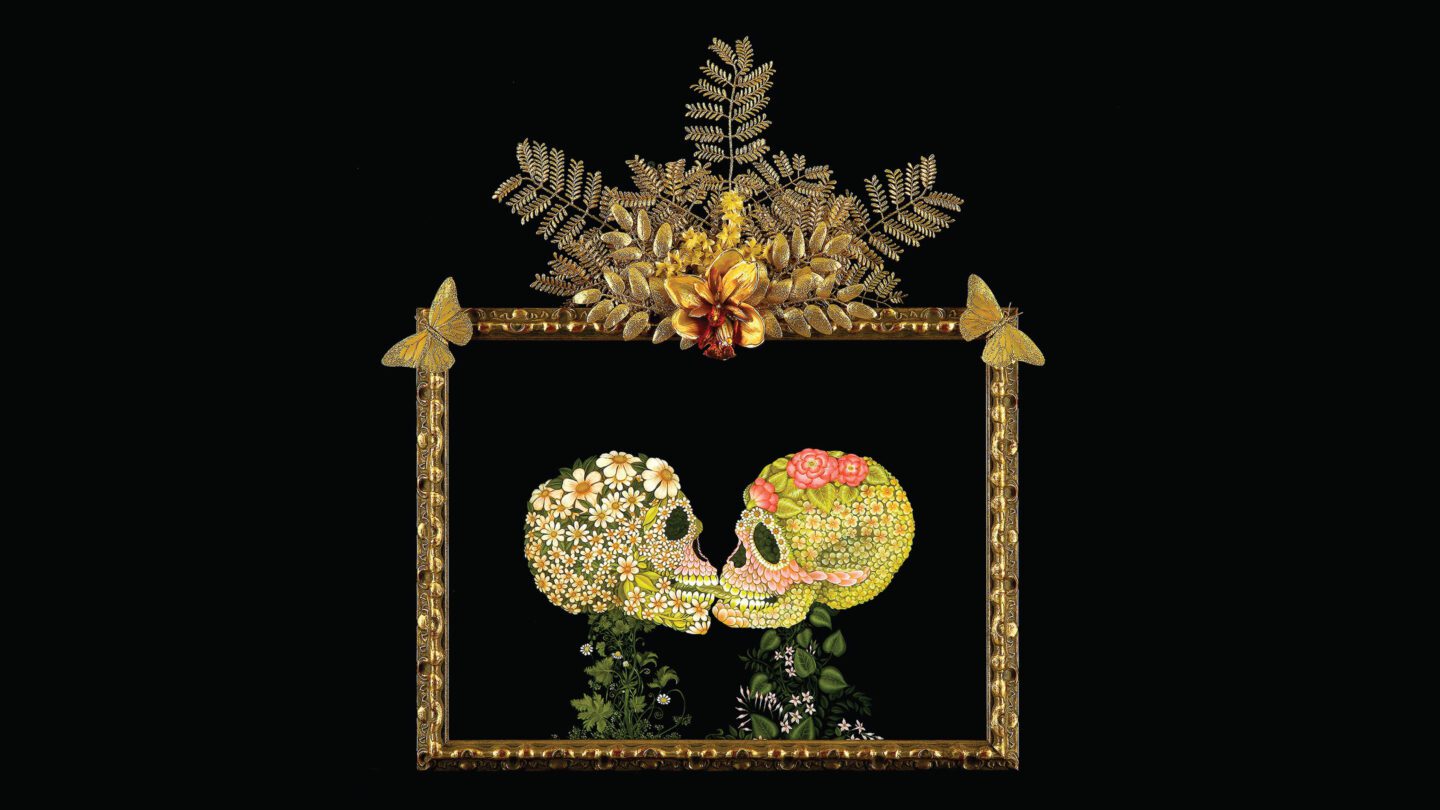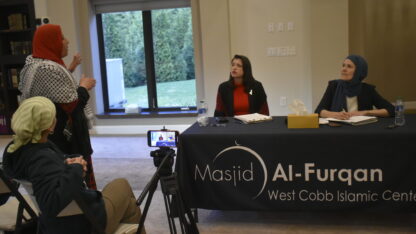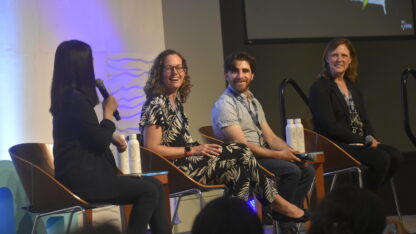Kennesaw Exhibit Shows How AIDS Changed American Art

Artist Tino Rodriguez’s “Eternal Lovers,” an oil on wood painting, will be on display at the “Art AIDS America” exhibit at the Zuckerman Museum of Art in Kennesaw.
On the walls of the Zuckerman Museum of Art in Kennesaw, Atlanta artist Robert Sherer’s piece is innocent enough. It’s an illustration in red ink of someone picking some flowers — the ornamental pink, red and white Sweet Williams — and putting them in a basket.
Again, it’s in red ink.
“It’s made with HIV-positive and negative blood,” Sherer explained.
He said the piece was inspired by a trip back home to Alabama in the late 1980s. At that time, a lot of his friends were leaving Atlanta to go home to die. Everyone thought that was why he was back home, but he was just there to visit his grandmother.
“While I was there, she asked me to go outside and cut a bouquet of the Sweet Williams, and I felt like the grim reaper at the time because several of my friends were dying of AIDS in Atlanta, who had names like Bill, Billy and William,” Sherer said. “It was hard on me. I remember breaking down when I was in her yard.”
Sherer’s piece is appearing in a new exhibition called “Art AIDS America” on display at the Zuckerman Museum of Art on Kennesaw State University’s campus from Feb. 20 through May 22.
“Sweet Williams” is one of many pieces of art in the exhibit that takes on the topic of HIV and AIDS in a more abstract way.
For example, at the entrance to one of the exhibit rooms, there’s a bead curtain by artist Feliz Gonzalez Torres.
“The original curtains were red and so it was about blood; it was about your HIV status and numbers, it was completely coded,” said Teresa Bramlette Reeves, the senior curator at the Zuckerman Museum of Art.
“Coded” art was common during the AIDS crisis because that was the only way to get art into museums. According to the “Art AIDS America” catalog, legislation passed in 1989 that restricted federal funding to art that delta with homosexuality and AIDS. That significantly reduced the amount of art that explicitly dealt with those topics in museums.
Not all the art that appears in “Art AIDS America,” though, is coded with double meanings. Some of it is quite explicit. There are portraits of people living with AIDS, and there’s a piece that speaks directly to the religious sentiment sweeping Congress during the 1980s.
In the exhibit space at the Zuckerman, each room highlights a different conversation surrounding AIDS, like safe sex, loss, drug use, spirituality and the individual experience.
“Art AIDS America” is a touring exhibition. It originally appeared at the Tacoma Art Museum.
Jonathan Katz is one of the original curators for the exhibition and is the art department chair at the University of Buffalo. He and Tacoma Art Museum’s Chief Curator Rock Hushka worked on “Art AIDS America” for ten years.
Katz explained the thesis of the exhibit: American art has been profoundly impacted by AIDS and so has American culture.
He said, “Rather than being a tragic tangent to American culture, AIDS has long been one of its defining motors.”
From the beginning, Katz and Hushka wanted to take this exhibit on tour to increase AIDS awareness around the country, but they encountered a problem they didn’t quite expect.
“It was hard to find museums that would take this exhibition,” Katz said. “One of the major challenges was that the conjunction of art, sexuality and AIDS is still very much the third rail in the American museum world.”
He thinks that’s due to the stigma around AIDS, a stigma that lingers on from the 1980s and 90s. At the height of the crisis, fear and discrimination ran throughout American culture and legislation. Anti-discrimination laws did not pass until 1990, and in the meantime people affected with HIV lost their jobs, their homes and were kicked out of school.
That was in part due to the fear around the illness. The population at large had many misconceptions about how it was spread, and HIV/AIDS primarily affected gay men, a marginalized group.
Even though it received positive reviews because of the caliber of work and the powerful message, Art AIDS America came under scrutiny at the Tacoma Art Museum. In December, just a few weeks before the exhibit closed, protestors staged a “die-in,” criticizing the exhibit for its lack of inclusion. Of the 107 artists in the exhibit, only four were black, and that’s a population that’s disproportionately affected by HIV and AIDS.
According to the Georgia Department of Health, 44 percent of adults living with HIV are black, nationally. In Georgia, it’s 64 percent.
The Zuckerman Museum jumped at the opportunity to host “Art AIDS America,” and they had a special opportunity. Senior curator Reeves said, “We got the opportunity to do something you usually don’t get to do when hosting an exhibit, and that’s to add to it.”
The Zuckerman staff added work from seven more African-America artists. They have organized several events tackling inclusion. They interviewed Kia Lebeija, the only woman of color in “Art AIDS America,” and Sur Rodney (Sur), an African-American writer and activist who contributed to the exhibit’s catalog.
They also created a community atrium area that hosts work by local artists and information from local HIV and AIDS activists groups like SisterLove to tell the Atlanta story of the disease.
“We thought telling the local story was really important,” Reeves said.
Katz and Hushka said they approve of these changes because, clearly, this exhibit is making conversations about AIDS actually happen. Hushka said, “We understand the importance of art and an artful protest and are grateful that we can be part of this process where art really proclaims a power, vital and urgent message.
Artist Sherer is also an art professor at Kennesaw State University. He said it’s important to have this exhibit at the Zuckerman so that students can see it.
Sherer said: “I am absolutely appalled at times by some of the ideas [my students] have about HIV and AIDS. Incredibly backward, ignorant ideas that somehow through the years, I guess the failure of elementary school or whatever it is, they’ve never really received any AIDS education along the way.”
Reeves followed up, “I think most people think of it as something of the past, but they don’t realize that’s it’s very much a viable and problematic epidemic.”
According to AIDS.gov, one in four new HIV diagnoses are found in people ages 13 to 24. In the United States, 1.2 million people are living with HIV and — even with treatments — 13,712 people died in 2012 from complications due to AIDS, according to the CDC.
Beyond awareness, though, this exhibit is a place to mourn.
“This is one of the few exhibitions where you will find a boxes of Kleenex in the gallery because for many of us, the feelings these works engender are in the shoebox in the closet under the sweaters,” Katz said.
Even though the stigma around AIDS extended to art museums and institutions, art was one of the ways that kept human conversation about AIDS alive during the crisis.
Katz said, “We saw among artists a thoughtful, nuanced accounting of what AIDS had done, an attempt to bring the epidemic into ordinary conversation.”
Sherer reflected upon how his friends used to joke, in the most somber and horrifying way possible, that he was “Queen Victoria.” Instead of a monarch mourning her husband for her long life, he’s a gay man mourning the loss of his friends.
“When I moved to Atlanta in the early 80s, I had not only my art school freshmen class of the young gay guys…I think I’m the only one who survived that,” he said. “I’m the only one pretty much surviving from my group of gay male friends in the…punk rock art scene, and even my mentors, they’re all pretty much gone now as well. I’m one of the people who witnessed a massive die off and I’m never going to get over it.”
Through remembrance and awareness, the curators at Tacoma and now at the Zuckerman want to make sure that something like the AIDS crisis doesn’t ever happen again. They also want to show the resilience of those who suffered and those who survived.
9(MDAxODM0MDY4MDEyMTY4NDA3MzI3YjkzMw004))





